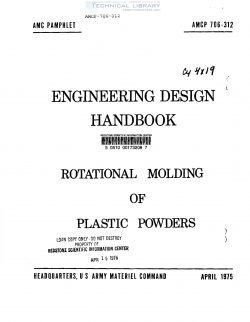AMCP-706-312
- Version
- 241 Downloads
- 5.81 MB File Size
- 1 File Count
- March 5, 2017 Create Date
- March 5, 2017 Last Updated
Engineering Design Handbook - Rotational Molding of Plastic Powders

1-1 DEFINITION Rotational molding, rotomolding, or roto- casting is a production process to form hollow parts of limitless size wherein liquid or pow- dered thermoplastic resins—and to a limited extent thermosetting materials—are charged into a split mold. The mold is then rotated continuously in a biaxial mode, in a high- temperature environment to above the resin melt temperature. When the plastic material has covered the inside of the mold and densified, the mold assembly while still rotat- ing is cooled to room temperature. The rotation is stopped and the part removed. 1-2 BACKGROUND Rotational molding is not a new procesing technique, having had a place in industry since the 1940's. The materials prior to 1961 were limited to vinyl plastisols in liquid form and were used primarily in the manufacture of novelties and decorative items such as artificial fruits, mannequins, children's toys, and hollow display items. What is new in rotational molding in recent years relates not to plastisols but to powdered resins of about 35 mesh which have triggered improvements in equipment design and the overall technology, making this technique among the major plastics processing methods of today. Therefore, this handbook will be devoted to the thermoplastic powdered engi- neering grade polymer rotational molding technology and not to plastisols which have little significance in the military complex.
1-3 MATERIALS In 1961, the first polyolefin powder, a low-density polyethylene, was publicly dem- onstrated to the rotational molding industry. Indications are that polyethylenes will remain one of the most popular materials for roto- molding, because of their processability, broad range of properties, and low cost. Today, however, most of the major thermo- plastic raw material suppliers have investi- gated specially formulated powders for rota- tional molding. These include impact styrene, polypropylene, nylons, acrylonitrile butadi- ene styrene, polycarbonate, acetals, ionomers, fluoropolymers, polybutylene, rigid polyvinyl chloride, and special grades of the cellulosics. They can be foamed or reinforced with fiberglass. In addition to the raw material suppliers, many rotational molders also have used custom grinding serwices or have their own in-plant grinding facilities, which also enlarges the material selection for this pro- cess.
| File | Action |
|---|---|
| AMCP-706-312 Engineering Design Handbook - Rotational Molding of Plastic Powders.pdf | Download |

Comment On This Post